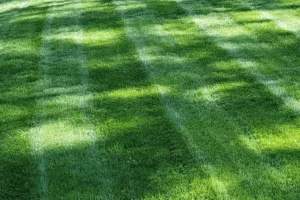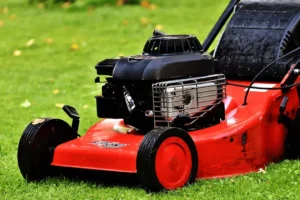
Introduction
The Challenge of Shaded Lawns
Every homeowner dreams of a lush, green lawn that is a testament to their gardening prowess. However, achieving this dream becomes challenging when large portions of the yard are shaded. Whether it’s due to tall trees, neighboring structures, or the property’s orientation, shaded areas can be a bane for many grass types. Most grasses thrive in direct sunlight; they become thin, patchy, and susceptible to diseases when deprived. This uneven growth can disrupt the aesthetic appeal of the lawn, leading to frustration and a constant search for solutions.
The challenges continue beyond just the lack of sunlight. Shaded areas often have different soil moisture levels compared to sunlit areas. They might retain more moisture due to reduced evaporation, leading to conditions that favor moss growth over grass. On the flip side, the dense canopy of trees might prevent rain from reaching the ground, causing dry patches. These micro-environments within the lawn require special attention and care, making the task even more daunting for homeowners.
Enter Fine Fescues
In the quest for the perfect shaded lawn, enter Fine Fescues – the unsung heroes of the grass world. These grasses are nature’s answer to the shade problem. Fine Fescues, with their slender leaves and delicate texture, have evolved to thrive in low-light conditions. Unlike their sun-loving counterparts, they don’t just survive in the shade; they flourish. Their ability to perform photosynthesis efficiently, even with limited sunlight, sets them apart and makes them the ideal choice for those tricky shaded patches.
But it’s not just about survival. Fine Fescues bring along a host of other benefits. Their deep green hue and fine texture can transform a lackluster shaded area into a carpet of verdant beauty. Moreover, their adaptability means they require less maintenance, making them a favorite among homeowners who prefer a low-fuss lawn. In the following sections, we’ll delve deeper into Fine Fescues, exploring their unique characteristics, maintenance tips, and much more. Whether you’re a seasoned gardener or a newbie, this guide promises insights to help you view your shaded lawn in a new light.
Understanding the Unique Shade Tolerance of Fine Fescues
Natural Habitat and Evolution
Fine Fescues’ fascinating evolutionary history has equipped them to thrive in shaded environments. Originating from woodlands, meadows, and other naturally shaded habitats, these grasses have adapted to lower light conditions over millennia. Fine Fescues have always had to compete with taller plants and trees for sunlight, unlike many other grass species that have evolved in open, sunlit areas. This competition has driven them to develop mechanisms to capture and utilize sunlight more efficiently, even when scarce.
Their natural habitats also exposed them to various soil types and moisture levels. Fine Fescues learned to adapt and thrive from the damp forest floors to the drier meadows. This adaptability is a testament to their resilience and is a significant reason why they are an excellent choice for modern lawns with shaded areas. Their evolutionary journey has prepared them to face the challenges of shaded lawns head-on, making them a reliable and robust choice for homeowners.
Photosynthesis Efficiency
Photosynthesis is the process by which plants convert sunlight into energy. For most plants, this process requires ample sunlight. However, Fine Fescues have developed a knack for performing photosynthesis even in suboptimal light conditions. Their leaves contain a higher concentration of chlorophyll, the pigment responsible for capturing sunlight, allowing them to absorb and utilize even the faintest rays. This efficiency ensures they can produce the energy they need to grow, even when sunlight is limited.
Furthermore, their leaf structure is optimized for shade. The slender, delicate leaves reduce self-shading, ensuring each leaf gets the maximum possible light. This design also means they have a larger surface area relative to their volume, allowing for more efficient gas exchange, a crucial component of photosynthesis. All these adaptations work in tandem to ensure that Fine Fescues can generate energy and thrive even in shaded conditions where other grasses might struggle.
Root System Adaptations
The magic of Fine Fescues isn’t just limited to what’s above the ground. Below the soil, a network of roots works tirelessly to support the grass. Fine Fescues have developed roots that can penetrate deeper into the soil in shaded conditions, where the topsoil might remain moist for extended periods. This deep-rooted system allows them to access nutrients and moisture from further below, ensuring their survival during dry spells.
Additionally, these deep roots help stabilize the soil, prevent erosion, and improve soil structure. They also form symbiotic relationships with fungi, known as mycorrhizae, which assist the grass in absorbing nutrients, especially in low-fertility soils commonly found in shaded areas. Working in harmony with the environment, this underground network ensures that Fine Fescues have all they need to grow lush and green, irrespective of the challenges posed by shade.
In essence, the shade tolerance of Fine Fescues is a combination of evolutionary adaptations, efficient photosynthesis mechanisms, and a robust root system. These factors combine to make Fine Fescues the champions of shaded lawns, bringing beauty and vitality to areas that might otherwise remain barren or patchy.
Maintaining a Healthy Lawn in Shaded Areas: Tips and Tricks
Soil Preparation
The foundation of any thriving lawn is the soil. Ensuring the soil is well-aerated and drains properly for shaded areas is crucial. Shaded areas, especially under large trees or structures, can retain too much moisture or become too dry, depending on the canopy’s density. Start by testing the soil’s pH level. Fine Fescues prefer slightly acidic to neutral pH levels (around 5.5 to 7.0). If the soil is too alkaline or acidic, consider adding lime or sulfur to balance it out.
In addition to pH, focus on improving soil structure. Incorporate organic matter like compost or well-rotted manure to enhance the soil’s nutrient content and water retention capabilities. For areas with compacted soil, consider aerating to allow better air, water, and nutrient penetration. Remember, well-prepared soil supports grass growth and promotes a healthy ecosystem of beneficial microbes and organisms that further aid lawn health.
Mowing Practices
While it might seem counterintuitive, mowing practices play a significant role in the health of shaded lawns. Fine Fescues in shaded areas should be mowed slightly higher than those in sunlit areas. A taller grass blade can capture more of the limited sunlight available, optimizing photosynthesis. Aim for a height of about 3 to 4 inches. Ensure your mower blades are sharp to prevent tearing the grass, which can make it susceptible to diseases.
Additionally, avoid mowing the lawn when it’s wet, especially in shaded areas. Wet grass clippings can clump together, creating a layer of thatch that might block sunlight and air from reaching the soil. Regularly mowing and avoiding cutting more than one-third of the grass blade length at a time will ensure the grass remains healthy and stress-free.
Watering Regimen
Watering shaded lawns requires a different approach than sunlit ones. Since shaded areas experience reduced evaporation, they tend to retain moisture longer. Overwatering can lead to waterlogged soil, promoting fungal diseases and root rot. Watering deeply but infrequently is essential, allowing the soil to dry out between watering sessions. Early morning is the best time to water, giving the grass ample time to dry before nightfall, reducing disease risk.
Investing in a soil moisture meter can be beneficial. It indicates when the lawn needs water, removing the guesswork from the equation. Remember, while Fine Fescues are shade-tolerant, they still need adequate moisture, especially during dry spells. Monitoring and adjusting your watering regimen based on the lawn’s needs will ensure it remains lush and healthy.
Fertilization Needs
Fine Fescues in shaded areas have different fertilization needs than those in full sun. Their nutrient requirements are also reduced since they grow slower in low-light conditions. Over-fertilizing can lead to excessive growth, making the grass more susceptible to diseases. Opt for a slow-release, balanced fertilizer that provides a steady supply of nutrients over time. Fertilizing in the early fall and late spring, when the grass is actively growing, is ideal.
It’s also worth noting that the fallen leaves can decompose and provide natural fertilization if your shaded area is under trees. Regularly mulching these leaves instead of removing them can offer additional nutrients to the soil. However, ensure the mulch layer is not too thick, as it might block sunlight and air.
Disease and Pest Prevention
Due to their moisture retention, shaded areas can become hotspots for fungal diseases like rust, powdery mildew, and dollar spot. Regularly inspecting the lawn for signs of diseases or pests can help early detection and treatment. Ensure proper air circulation by thinning out or pruning overhanging branches. This reduces moisture retention and allows more sunlight to reach the grass.
For pest control, consider introducing beneficial insects like ladybugs and lacewings that prey on common lawn pests. If you notice any disease or pest infestation, consult a lawn care professional or local nursery for treatment options. Remember, prevention is always better than cure. Maintaining a healthy lawn and monitoring it regularly can prevent most diseases and pests from taking hold.
In conclusion, while maintaining a shaded lawn might seem challenging, it’s achievable with the proper knowledge and practices. By understanding the unique needs of Fine Fescues and adjusting your lawn care regimen accordingly, you can enjoy a beautiful green oasis even in the most shaded corners of your property.
Pros and Cons of Mixing Fine Fescues with Other Grass Types
Pros
- Diversity in Texture and Appearance
- Mixing Fine Fescues with other grass types can create a multi-dimensional look for your lawn. Combining different grass textures and shades of green can result in a more visually appealing and dynamic landscape. For instance, the delicate blades of Fine Fescues combined with the broader leaves of Kentucky Bluegrass can create a beautiful contrast.
- This diversity isn’t just about aesthetics. A mixed lawn can also mimic natural grassland ecosystems, often composed of various grass species coexisting. This can attract a broader range of beneficial insects and wildlife, enhancing your yard’s biodiversity.
- Enhanced Resilience
- A mixed lawn can be more resilient to various stresses. While Fine Fescues excel in shade, other grass types might be more drought-resistant or tolerant to foot traffic. By mixing them, you can harness the strengths of multiple species, ensuring that your lawn remains green and healthy under a range of conditions.
- This resilience also extends to pest and disease resistance. Different grass types can be susceptible to different pests and diseases. By diversifying the grass species in your lawn, you reduce the risk of the entire lawn getting affected by a single pest or disease outbreak.
- Beneficial Symbiotic Relationships
- Certain grass combinations can support each other’s growth. For instance, some grass species might release nutrients that Fine Fescues can utilize, and vice versa. This mutual benefit can lead to a healthier and more vibrant lawn.
- These symbiotic relationships can also extend below the ground. Different grass species have varying root depths. Mixing them ensures the entire soil profile is utilized, leading to better soil aeration and structure.
Cons
- Inconsistent Growth Patterns
- Different grass types grow at different rates. Over time, one species might dominate, overshadowing the others. This can lead to an uneven lawn, with patches of dense growth interspersed with thinner areas. Regular mowing and maintenance might be required to keep the growth in check and maintain a balanced appearance.
- Seasonal variations can further exacerbate this issue. Some grasses might thrive in spring, while others might have their growth spurt in fall. This can lead to a constantly changing lawn appearance, which might not be to everyone’s liking.
- Varied Maintenance Needs
- Each grass type has maintenance requirements, from mowing height to fertilization needs. Catering to the needs of multiple grass types simultaneously can be challenging. You might need to adjust your lawn care regimen frequently, ensuring that each grass type gets the required care.
- Watering can be particularly tricky. While Fine Fescues might prefer deep, infrequent watering, other grass types in the mix might have different requirements. Striking the right balance to ensure all species thrive can be a challenge.
- Potential for Dominance
- Over time, one grass type might outcompete the others, especially if the lawn conditions favor its growth. This can lead to a loss of diversity, with the dominant grass type taking over large patches. Regular overseeding might be required to maintain the desired grass mix.
- This dominance isn’t just about the growth rate. Some grass species might release chemicals that inhibit the growth of neighboring plants, a phenomenon known as allelopathy. If such a species is part of the mix, it might suppress the growth of Fine Fescues and other grass types.
While mixing Fine Fescues with other grass types can offer several benefits, knowing the potential challenges is essential. By understanding these pros and cons, homeowners can make informed decisions, ensuring their mixed lawn remains a source of pride and joy for years.
Frequently Asked Questions
What makes Fine Fescues unique compared to other grass types?
Fine Fescues are known for their exceptional shade tolerance. Originating from naturally shaded habitats, they have evolved to capture and utilize sunlight efficiently, even in low-light conditions. Their slender leaves, high chlorophyll concentration, and deep-rooted system make them ideal for shaded lawns.
How do Fine Fescues perform photosynthesis in shaded conditions?
Fine Fescues have a higher concentration of chlorophyll, allowing them to absorb and utilize even faint sunlight. Their slender leaves reduce self-shading and have a larger surface area relative to their volume, enabling efficient gas exchange, crucial for photosynthesis.
Why is soil preparation essential for shaded lawns?
Proper soil preparation ensures the lawn has the right pH level, structure, and nutrient content. Shaded areas can either retain too much moisture or become too dry. Testing and adjusting the soil’s pH, improving its structure with organic matter, and ensuring proper aeration can help Fine Fescues thrive in these conditions.
How should I mow Fine Fescues in shaded areas?
Fine Fescues in shaded areas should be mowed slightly higher (about 3 to 4 inches) than those in sunlit areas to capture more limited sunlight. Ensure mower blades are sharp to prevent tearing the grass and avoid mowing when the lawn is wet.
What watering practices are best for Fine Fescues in shaded lawns?
Shaded lawns tend to retain moisture longer. It’s essential to water deeply but infrequently, allowing the soil to dry out between watering sessions. Watering early in the morning is best, as it gives the grass time to dry before nightfall, reducing disease risk.
How often should I fertilize Fine Fescues in shaded areas?
Fine Fescues in shaded areas have reduced nutrient requirements due to slower growth. Opt for a slow-release, balanced fertilizer and apply it during the early fall and late spring when the grass is actively growing. Avoid over-fertilizing to prevent excessive growth and susceptibility to diseases.
Can I mix Fine Fescues with other grass types?
Yes, mixing Fine Fescues with other grass types can offer benefits like diversity in texture, enhanced resilience, and beneficial symbiotic relationships. However, there are challenges like inconsistent growth patterns, varied maintenance needs, and potential dominance by one grass type.
How can I prevent diseases and pests in shaded lawns?
Ensure proper air circulation by thinning out or pruning overhanging branches. Water early in the morning, inspect the lawn regularly for signs of diseases or pests, and introduce beneficial insects like
Conclusion
The Versatility of Fine Fescues
Fine Fescues have emerged as a hope for homeowners grappling with shaded lawns. Their unique shade tolerance, aesthetic appeal, and low maintenance needs make them a standout choice. Originating from naturally shaded habitats, these grasses have evolved to capture even the faintest rays of sunlight, ensuring they remain green and vibrant. Their slender leaves and deep-rooted system enhance their adaptability, allowing them to thrive where many other grass types falter.
However, their versatility extends beyond just shade tolerance. Fine Fescues are also known for their ability to coexist with other grass types. This ability to play well with others opens up a world of possibilities for homeowners. From creating diverse, textured landscapes to building resilient lawns that withstand various stresses, Fine Fescues prove they are more than just a one-trick pony.
Making Informed Choices
The journey to a lush, green lawn, especially in shaded areas, is filled with challenges. However, these challenges can be overcome with the proper knowledge and tools. The key lies in understanding the specific needs of your lawn and making informed choices. Whether selecting the right grass mix, adjusting your maintenance regimen, or seeking professional advice, every decision should be rooted in knowledge.
This guide aimed to shed light on the world of Fine Fescues and their care. We covered everything from their unique shade tolerance to tips and tricks for maintaining a healthy lawn. However, the journey continues. As with all things in nature, lawns are dynamic, ever-changing ecosystems. Continuous learning, observation, and adaptation are essential to ensure your lawn remains a source of pride and joy.
The Beauty of a Shaded Lawn
Often, shaded lawns are viewed as a challenge, a problem to be solved. However, with a shift in perspective, they can be seen as an opportunity to create a unique landscape, different from the cookie-cutter sunlit lawns. Fine Fescues, with their shade-loving nature, offer a chance to transform these shaded patches into verdant oases.
Fine Fescues, with their delicate blades and shade-loving nature, have carved a niche for themselves in the world of lawn care. Their ability to thrive in conditions where many other grass types struggle is a testament to their resilience and adaptability. Homeowners who have discovered the magic of Fine Fescues often find themselves captivated by their lush green hue and the tranquility they bring to shaded areas. These grasses are not just about aesthetics; they represent nature’s solution to the challenges of shaded lawns.
Beyond their beauty, Fine Fescues also embody sustainability. Their low maintenance needs mean reduced water usage, fewer fertilizer applications, and less frequent mowing. In an age where sustainable living is gaining prominence, choosing Fine Fescues is a step towards creating eco-friendly outdoor spaces. Their deep-rooted systems prevent soil erosion, and their ability to coexist with other plants promotes biodiversity, further enhancing their environmental credentials.
The Journey of Lawn Care
Lawn care is a journey, not a destination. It’s a continuous process of learning, adapting, and growing. Every lawn, with its unique set of challenges and conditions, offers a chance to connect with nature and discover the joys of gardening. Fine Fescues, with their shade tolerance and versatility, have made this journey easier and more rewarding for many. However, as with all plants, they require care, attention, and understanding.
The insights and tips shared in this guide aim to simplify the process of lawn care, especially for shaded areas. However, the real magic lies in observation. By closely observing your lawn, understanding its needs, and responding accordingly, you can create a thriving ecosystem right in your backyard. Whether it’s adjusting the watering schedule, experimenting with different grass mixes, or seeking expert advice, every step you take is a step towards a healthier, greener lawn.
Looking Ahead
As we conclude this guide, it’s essential to look ahead and envision the possibilities. With the knowledge you’ve gained, imagine the transformation your shaded lawn can undergo. From barren patches to lush green carpets, the change can be dramatic and deeply satisfying. Fine Fescues, with their myriad benefits, can be the catalyst for this transformation.
In the end, lawn care is as much an art as it is a science. It’s about forging a bond with the land, understanding its rhythms, and nurturing it. With patience, persistence, and a dash of passion, you can create outdoor spaces that are not just visually appealing but also environmentally responsible. Here’s to the joy of gardening and the endless possibilities it brings!

Bob Green, a passionate lawn care enthusiast with over two decades of landscaping experience, is this website’s proud owner. His vast knowledge of horticulture and dedication to helping homeowners maintain beautiful lawns are reflected in the valuable content he shares on his platform. John has always been interested in Agrostology.














